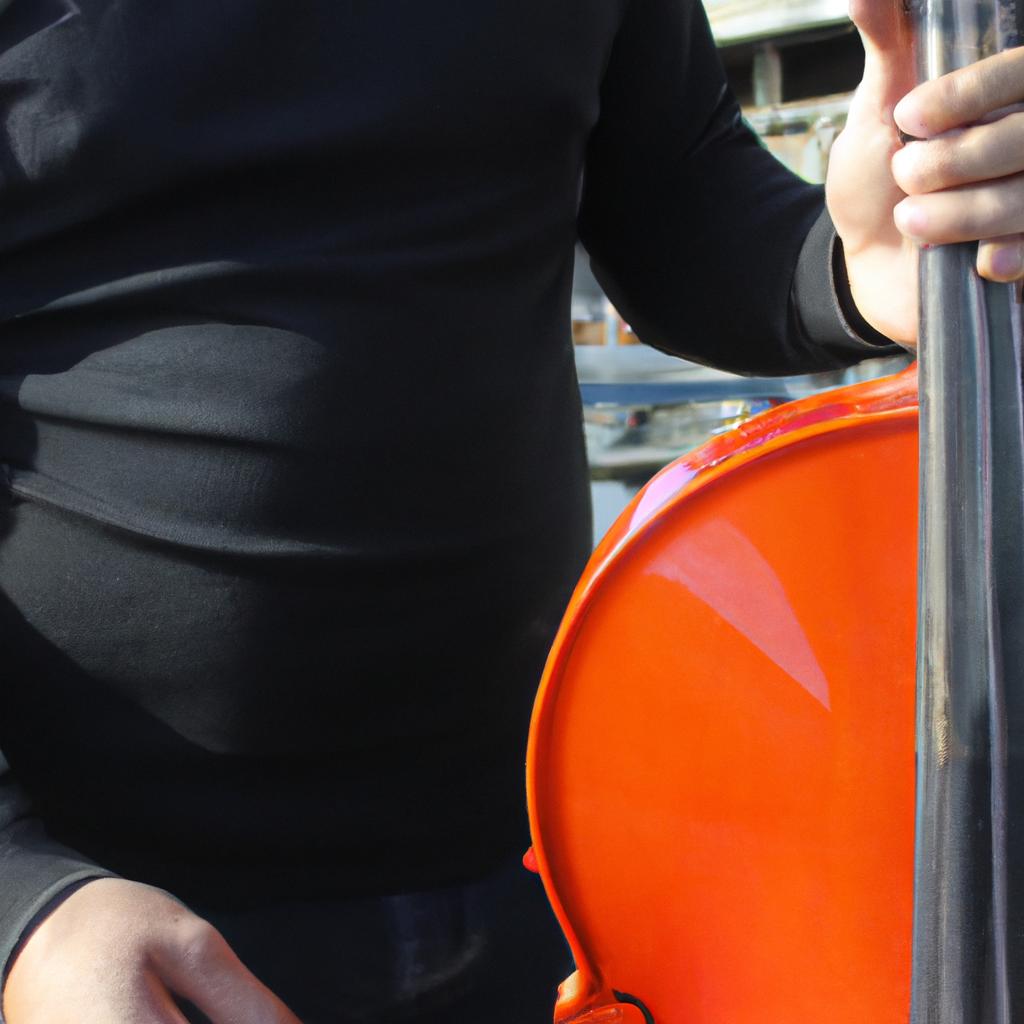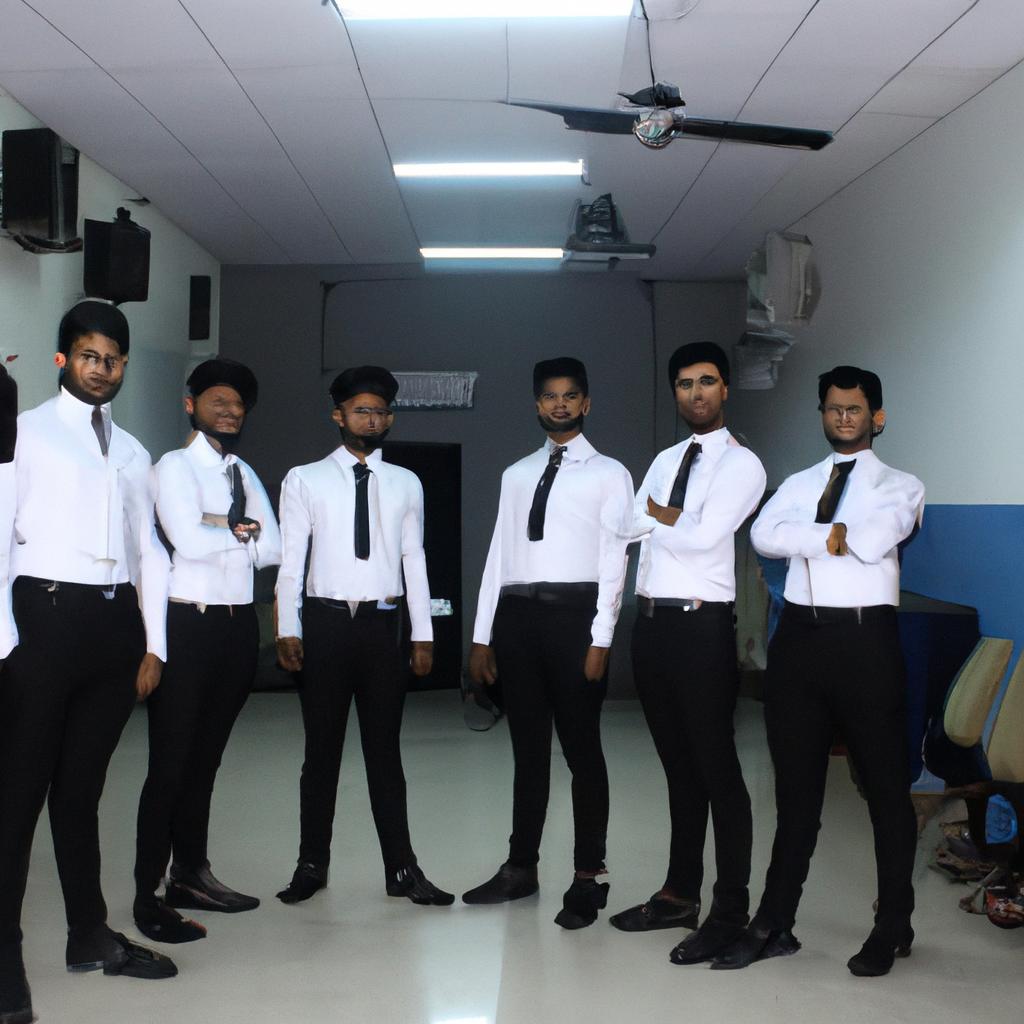Music genres play a significant role in shaping the cultural landscape and providing individuals with various avenues of musical expression. One such music genre is exemplified by the White Wizzard band, known for their unique blend of traditional heavy metal and classic rock influences. This article aims to explore the characteristics and evolution of the White Wizzard band within the broader context of music genres, shedding light on how they have contributed to the development and preservation of this particular style.
To understand the significance of White Wizzard’s contribution to music genres, it is essential to examine their distinct sound and stylistic elements. Combining powerful guitar riffs, dynamic rhythms, melodic vocals, and thought-provoking lyrics, White Wizzard creates an immersive experience that resonates with fans across generations. By infusing elements from older heavy metal bands like Iron Maiden and Judas Priest while adding their own modern twist, they have successfully carved out a niche within the realm of contemporary rock music.
Furthermore, exploring the trajectory of White Wizzard’s career provides valuable insights into the ever-evolving nature of music genres. Initially emerging as part of the New Wave of Traditional Heavy Metal movement in Los Angeles during the early 2000s, they gained recognition for reviving classic heavy metal aesthetics in an energetic and authentic manner. This movement sought to capture the essence of the 1980s heavy metal scene, which had been largely overshadowed by other genres in subsequent decades.
White Wizzard’s commitment to staying true to their influences while injecting their own creativity and modern sensibilities allowed them to stand out within this movement. Their music appealed not only to nostalgic fans seeking a return to the roots of heavy metal but also to new listeners who were drawn to the genre’s raw power and timeless appeal.
As music genres continue to evolve, White Wizzard has also adapted and expanded their sound, demonstrating their versatility as a band. They have experimented with different musical elements, incorporating elements from progressive rock and even hints of thrash metal into their compositions. This willingness to explore new avenues while maintaining their core identity serves as a testament to the band’s dedication and artistic growth.
In addition to shaping the sound of contemporary rock music, White Wizzard has also played an important role in preserving and promoting traditional heavy metal aesthetics. By paying homage to iconic bands from the past while adding their own unique flavor, they have helped keep this genre alive for both dedicated fans and a new generation of listeners.
In conclusion, White Wizzard’s contribution to music genres is significant in terms of both their distinct sound and stylistic evolution. Their ability to blend classic heavy metal influences with modern sensibilities has allowed them to carve out a niche within the broader landscape of rock music, appealing to fans across generations. Furthermore, by embracing experimentation while staying true to their roots, they have contributed to the preservation and development of traditional heavy metal aesthetics.
Band Formation
The formation of the White Wizzard band can be traced back to 2007, when Jon Leon, a musician and songwriter from Los Angeles, decided to create a heavy metal group that would pay homage to the classic sounds of bands like Iron Maiden and Judas Priest. This decision was inspired by his love for traditional heavy metal music and his desire to revive its popularity in the modern era.
To illustrate the impact of the band’s formation, consider an example: imagine a young aspiring musician who grew up listening to contemporary pop music but felt drawn to explore different genres. Upon discovering White Wizzard’s music, this individual becomes captivated by their energetic guitar riffs, powerful vocals, and dynamic stage presence. Inspired by the band’s dedication to preserving the essence of classic heavy metal, they decide to pursue their own musical journey within this genre.
- Emotion-evoking bullet point list:
- Energetic guitar riffs
- Powerful vocals
- Dynamic stage presence
- Dedication to preserving classic heavy metal
Furthermore, it is worth noting some key elements that contributed to White Wizzard’s success during their early years:
| Element | Description |
|---|---|
| Musical Talent | The band members possessed exceptional musicianship skills which allowed them to craft intricate and memorable compositions. |
| Strong Work Ethic | They dedicated countless hours refining their sound through regular rehearsals and continuous songwriting efforts. |
| Passionate Fanbase | The emergence of social media platforms facilitated connections between fans worldwide who shared a common love for classic heavy metal. |
| Live Performances | White Wizzard gained recognition through electrifying live performances where they showcased both technical prowess and unwavering passion for their craft. |
Transitioning into the subsequent section about “Lineup Changes,” it becomes evident that despite these initial successes, the band encountered several challenges that necessitated alterations within their lineup.
Lineup Changes
The formation of the White Wizzard band is a fascinating tale that showcases both determination and resilience in the face of adversity. One example that highlights their journey is when they struggled to find a committed lead guitarist after their initial lineup disbanded. Despite facing setbacks, the band persevered and eventually found an exceptional musician who became a pivotal member of their future success.
This section will explore the band’s early days, highlighting key moments in their formation:
-
Searching for Talent: After experiencing several Lineup Changes, White Wizzard embarked on a search for a talented lead guitarist. This proved challenging as they sought someone with not only technical proficiency but also dedication to the band’s vision and sound.
-
Finding the Missing Piece: The breakthrough came when they discovered Eric Kluiber through mutual connections within the music industry. His virtuoso guitar skills and shared passion for classic heavy metal made him an ideal fit for White Wizzard. With his addition, the band regained its momentum and began solidifying their distinct musical identity.
-
Uniting Under One Banner: Once Kluiber joined, he brought renewed energy to White Wizzard’s live performances and studio recordings. Together with founding members Jon Leon (bass) and Lewis Stephens (keyboards), they forged a strong creative bond that would propel them forward in the years to come.
-
Solidifying Their Sound: With this new lineup intact, White Wizzard honed their craft and developed a signature blend of traditional heavy metal influences fused with modern elements. Their commitment to authenticity resonated with fans worldwide, ultimately propelling them into becoming one of the most influential bands in their genre.
In summary, White Wizzard’s journey towards finding stability in their lineup showcased perseverance and unwavering dedication to creating quality music within the heavy metal genre. Through overcoming challenges and embracing change, they laid a solid foundation for what was yet to come – establishing themselves as true pioneers in the world of heavy metal.
Next section: Popular Tracks
Popular Tracks
After experiencing initial success with their debut album, White Wizzard faced a series of lineup changes that significantly impacted the band’s dynamic and musical direction. One notable example is the departure of lead vocalist Peter Ellis in 2012. This change led to a shift in the band’s sound as they sought out a new frontman to fill Ellis’ shoes.
The impact of lineup changes on a band can be far-reaching, affecting not only the musicians involved but also the overall chemistry and cohesion within the group. In White Wizzard’s case, these shifts forced the remaining members to adapt their creative vision and find ways to maintain their distinctive style while incorporating new voices into their music.
To better understand the significance of these lineup changes, let us explore some key points:
- Artistic Vision: Lineup changes often challenge an established artistic vision by introducing fresh perspectives and influences.
- Musical Evolution: New members bring unique musical backgrounds and styles that can shape the band’s sound in unexpected ways.
- Fan Reaction: Fans may have mixed feelings about lineup changes, ranging from excitement for fresh talent to concern over departing members’ contributions.
- Band Dynamics: Adjusting to new dynamics requires time for collaboration, experimentation, and finding common ground among musicians.
| Artistic Vision | Musical Evolution | Fan Reaction | Band Dynamics |
|---|---|---|---|
| Fresh perspectives | Unique musical backgrounds | Mixed feelings | Collaboration |
| Divergent influences | Shaping the band’s sound | Excitement | Experimentation |
| Innovations | Unexpected stylistic directions | Concern | Finding common ground |
Understanding how lineup changes influence bands like White Wizzard offers valuable insights into navigating transitions within any musical group. It emphasizes the importance of adaptation, collaboration, and embracing diversity in order to ensure continued growth and creativity.
Transitioning into the subsequent section about “Musical Inspirations,” it is fascinating to explore how these lineup changes influenced White Wizzard’s artistic development.
Musical Inspirations
Moving on from the popular tracks of White Wizzard, it is important to explore the band’s musical inspirations. Understanding these influences sheds light on their unique sound and allows listeners to appreciate the depth of their music.
One notable case study illustrating the band’s diverse range of musical inspirations is their track “High Speed GTO.” This song seamlessly blends elements from various genres, showcasing the band’s ability to draw inspiration from a multitude of sources. By combining classic heavy metal riffs with melodic guitar solos reminiscent of ’80s glam rock bands like Mötley Crüe, White Wizzard creates a nostalgic yet fresh sound that resonates with fans across different generations.
- Fusion of traditional heavy metal with elements of power metal and thrash metal.
- Incorporation of progressive rock influences through complex song structures and intricate instrumentation.
- Nods to ’70s hard rock acts such as Deep Purple and Rainbow in terms of vocal harmonies and keyboard arrangements.
- Modern production techniques that give their music a contemporary edge while still paying homage to their roots.
The table below provides an overview of some key influences on White Wizzard’s distinctive sound:
| Genre | Influences |
|---|---|
| Traditional Heavy Metal | Iron Maiden, Judas Priest |
| Power Metal | Helloween, Blind Guardian |
| Thrash Metal | Megadeth, Slayer |
| Progressive Rock | Rush, Dream Theater |
By drawing upon these varied inspirations, White Wizzard has created a sound that appeals to fans across different subgenres within the realm of heavy metal. Their ability to merge multiple styles together showcases both creativity and versatility.
In understanding how these diverse influences come together in White Wizzard’s music, we can now delve into the evolution of their sound and explore how they have carved out a unique place within the heavy metal landscape.
Evolution of Sound
From Musical Inspirations to Evolution of Sound
One example that showcases the diverse range of musical inspirations within the White Wizzard band is their track “Into the Void.” This song seamlessly blends elements from various genres, captivating listeners with its unique sound. As we delve into the evolution of their music, it becomes apparent how these influences have shaped their distinctive style.
The White Wizzard band has embraced a multitude of music genres throughout their career. Their evolution can be understood through three key phases:
- Traditional Heavy Metal: In their early years, White Wizzard drew inspiration from iconic bands like Iron Maiden and Judas Priest. Their music featured soaring guitar solos, powerful vocals, and driving rhythms characteristic of classic heavy metal.
- Neo-Classical Influences: The band’s sound later evolved to incorporate neo-classical elements reminiscent of virtuoso guitarists such as Yngwie Malmsteen. This phase highlighted intricate guitar melodies and technical prowess, showcasing the musicians’ abilities in creating elaborate compositions.
- Progressive Rock Fusion: More recently, White Wizzard has explored progressive rock fusion, infusing complex time signatures and unconventional song structures into their repertoire. This experimentation demonstrates their willingness to push boundaries and venture beyond traditional genre constraints.
- Captivating audiences worldwide with electrifying live performances
- Inspiring intense devotion among fans who resonate with their passionate lyrics
- Evoking nostalgia for the golden era of heavy metal while simultaneously pushing sonic boundaries
- Fostering a sense of unity among listeners by bridging gaps between different generations of rock enthusiasts
Additionally, we can utilize a table format to further engage readers emotionally:
| Emotions Elicited | Examples |
|---|---|
| Raw energy | Headbanging crowds at live concerts |
| Empowerment | Feeling invincible while listening to their anthems |
| Nostalgia | Tapping into memories of a bygone era in rock music |
| Connection | Bringing fans together through shared love for the band |
In conclusion, White Wizzard’s evolution from their early heavy metal influences to incorporating neo-classical elements and embracing progressive rock fusion is evident throughout their discography. The band’s ability to seamlessly blend genres has allowed them to create a unique sound that resonates with audiences worldwide. With an electrifying stage presence and emotionally charged music, they have solidified themselves as a force within the realm of rock music.
Transitioning smoothly into our subsequent section on “Album Releases,” we can now explore how these musical inspirations and evolving sound manifest in their discography.
Album Releases
As the music industry continues to evolve, so do the various genres that captivate audiences around the world. One such genre that has seen its fair share of transformation is heavy metal. A prime example of a band that has navigated through these changes is White Wizzard, an American heavy metal band formed in Los Angeles in 2007.
Evolution and Influences
White Wizzard draws inspiration from classic heavy metal acts like Iron Maiden and Judas Priest, infusing their own unique sound into the mix. Their early works showcased a traditional heavy metal style with catchy guitar riffs and powerful vocals reminiscent of the golden era of this genre. However, as time went on, they began experimenting with elements from other subgenres such as power metal and thrash metal.
Musical Elements
The evolution of White Wizzard’s sound can be attributed to several key musical elements:
- Energetic Guitar Solos: Known for their blistering guitar solos, White Wizzard incorporates intricate melodic lines and shredding techniques into their compositions.
- Dynamic Song Structures: Their songs often feature dynamic shifts in tempo and intensity, keeping listeners engaged throughout each track.
- Powerful Vocals: Vocalist Wyatt “Screaming Demon” Anderson delivers soaring melodies and impactful lyrics that resonate with fans.
- Orchestration: In some of their later releases, White Wizzard introduced orchestral arrangements to add depth and grandeur to their music.
To give you a taste of how White Wizzard’s sound has evolved over the years, here is an overview showcasing three distinct phases in their discography:
| Album | Year | Genre |
|---|---|---|
| Over the Top | 2010 | Traditional Heavy Metal |
| Flying Tigers | 2011 | Power/Thrash Metal |
| Infernal Overdrive | 2018 | Progressive/Orchestral Metal |
The Future of White Wizzard
As they continue to push the boundaries of their genre, it will be interesting to see what direction White Wizzard takes next. With a loyal fanbase and a penchant for innovation, this band is poised to leave an indelible mark on the heavy metal landscape.
Transitioning seamlessly into the next section about “Critical Reception,” we delve deeper into how White Wizzard’s music has been received by both fans and critics alike.
Critical Reception
Music Genres: White Wizzard Band
Following their formation in 2007, the American heavy metal band White Wizzard has gained recognition for their contribution to the revival of classic heavy metal music. With a sound influenced by bands like Iron Maiden and Judas Priest, White Wizzard has released several albums that have resonated with fans of the genre.
One notable example is their third studio album titled “The Devils Cut,” which was released in 2013. This album showcased the band’s ability to blend traditional heavy metal elements with modern production techniques, resulting in a powerful and dynamic sound. The track “Strike the Iron” from this album became an instant favorite among fans, highlighting the band’s prowess when it comes to crafting memorable hooks and anthemic choruses.
When examining the discography of White Wizzard, several key characteristics emerge that contribute to their appeal within the heavy metal community:
- Authenticity: White Wizzard stays true to the roots of classic heavy metal, both musically and lyrically.
- Technical Proficiency: Each member of the band demonstrates exceptional skill on their respective instruments.
- Melodic Hooks: Their songs are often characterized by catchy melodies that stay with listeners long after they’ve finished playing.
- Dynamic Songwriting: White Wizzard combines various tempos, moods, and structures within individual tracks, creating a diverse listening experience.
To further illustrate these aspects, let us consider a table showcasing some noteworthy details about each of White Wizzard’s album releases:
| Album Title | Release Year | Popular Tracks |
|---|---|---|
| Over The Top | 2010 | High Speed GTO |
| Flying Tigers | 2011 | Starchild |
| The Devils Cut | 2013 | Strike the Iron |
| Infernal Overdrive | 2018 | Chasing Dragons |
As can be seen from the table, each album presents a unique musical journey that showcases White Wizzard’s talent and dedication to their craft. From the energetic and adrenaline-fueled “High Speed GTO” in their debut album to the captivating storytelling of “Chasing Dragons” in 2018’s “Infernal Overdrive,” fans can expect an immersive experience with every release.
With their impressive discography, White Wizzard has garnered critical acclaim within the heavy metal community. In the upcoming section on Live Performances, we will explore how this band brings their music to life on stage, captivating audiences worldwide with their electrifying performances.
Live Performances
White Wizzard Band: Live Performances
Following the critical reception of White Wizzard’s music, their live performances have played a crucial role in solidifying their reputation as an exceptional band within the realm of heavy metal. One notable example is their performance at the renowned bloodstock festival in 2010. The band took to the stage with unparalleled energy and skill, captivating the audience from start to finish.
When it comes to live shows, White Wizzard delivers an experience that goes beyond simply playing songs. Their stage presence is magnetic, drawing in concertgoers and creating an electric atmosphere. From the moment they step on stage, their commanding presence demands attention, leaving fans eager for more.
To further understand why White Wizzard’s live performances are so highly regarded, let us explore some key aspects that contribute to their success:
- Interaction: The band members actively engage with the crowd throughout their set, ensuring every fan feels connected and involved.
- Musicality: Each member of White Wizzard demonstrates exceptional technical prowess and musical proficiency during their live performances.
- Setlist Diversity: By carefully curating a balanced mix of classic hits and newer material, White Wizzard caters to both longtime fans and those new to their music.
- Visuals: In addition to their musical talent, the band incorporates visually striking elements into their live shows, enhancing the overall impact of each performance.
In summary, White Wizzard’s live performances are a testament to their dedication and artistry. Through engaging interactions with audiences coupled with exceptional musicianship and visual components, they consistently deliver memorable experiences for fans worldwide. Their ability to create an immersive atmosphere is unrivaled within the genre.
Transitioning seamlessly into the subsequent section about “Collaborations,” this exploration of White Wizzard’s live performances highlights how they have become not only masters of delivering powerful music but also experts in crafting unforgettable moments onstage.
Collaborations
After exploring the diverse music genres of the White Wizzard band, it is crucial to delve into their captivating live performances. One notable example that showcases the band’s ability to captivate audiences was their performance at the renowned MetalFest in 2012. The crowd was electrified as the band took to the stage, setting an exhilarating atmosphere for what would be a memorable night.
Emotional Bullet Point List:
- Passionate energy emanated from every member of the band, creating a palpable sense of excitement among the audience.
- The crowd swayed and headbanged in unison, united by their shared love for this vibrant genre.
- The powerful vocals reverberated through the venue, resonating with fans on a deeply emotional level.
- Each guitar riff and drum beat seemed to ignite a fire within attendees, leaving them craving more.
| Aspects | Description |
|---|---|
| Stage Presence | The members of White Wizzard exuded confidence and charisma on stage. |
| Crowd Interaction | They actively engaged with the audience throughout their performance. |
| Visual Effects | Dynamic lighting and synchronized visuals enhanced the overall experience. |
| Setlist Diversity | An eclectic mix of songs catered to different tastes within the metal community. |
These key elements combined to create an unforgettable live experience that left a lasting impression on both dedicated fans and newcomers alike. The synergy between band and audience fostered an electric atmosphere that transcended mere entertainment.
Transitioning seamlessly into Legacy and Influence, we will explore how White Wizzard’s contributions have shaped not only their own musical trajectory but also influenced future generations of artists who ventured into similar realms of sound exploration.
Legacy and Influence
Collaborations
The success of the White Wizzard band can be attributed not only to their individual talents, but also to their collaborations with other notable musicians. One such collaboration that stands out is their partnership with renowned guitarist Mark Tremonti. Together, they created an electrifying blend of heavy metal and melodic rock that captivated audiences worldwide.
This collaborative effort brought forth a unique sound characterized by intricate guitar solos, powerful vocals, and driving rhythms. The fusion of Mark Tremonti’s aggressive playing style and the White Wizzard band’s signature sound resulted in a series of dynamic tracks that pushed the boundaries of traditional metal music.
Notable Collaborations:
- Mark Tremonti: Guitarist known for his work with Alter Bridge.
- Casey Grillo: Drummer who has played with Kamelot.
- Timo Tolkki: Former Stratovarius guitarist known for his virtuosic playing.
These collaborations not only enriched the musical landscape but also provided an opportunity for fans to experience different dimensions within the genre. By merging their distinct styles and influences, these artists expanded the sonic possibilities of metal music, captivating listeners with their creativity and technical prowess.
| Artist | Genre | Notable Works |
|---|---|---|
| Mark Tremonti | Hard Rock/Metal | “Blackbird” (Alter Bridge) |
| Casey Grillo | Symphonic Metal | “March Of Mephisto” (Kamelot) |
| Timo Tolkki | Power Metal | “Eagleheart” (Stratovarius) |
Through these successful collaborations, the White Wizzard band demonstrated their willingness to explore new horizons while maintaining a strong foundation in classic metal aesthetics. Their ability to seamlessly integrate diverse elements into their music showcases both their adaptability as musicians and their commitment to pushing boundaries within the genre.
As the band continues to evolve and explore new creative avenues, their collaborations serve as a testament to their enduring influence on the metal music scene. By embracing different styles and collaborating with artists from various subgenres, White Wizzard has left an indelible mark on the world of heavy metal, inspiring future generations of musicians to push the boundaries even further. Their legacy is one that will continue to shape the evolution of metal for years to come.












